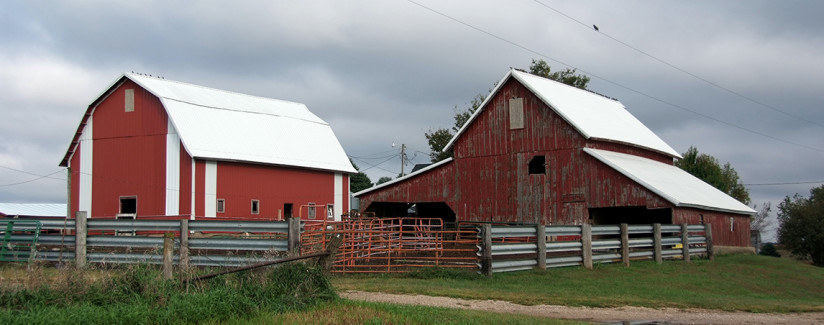
“Contract production put farmers at an economic disadvantage and harms farming communities.”
10/24/2013
Like other business owners, farmers have different skills, expertise, financial positions, and appetites for risk. Reducing costs and risk through contracts allows a farmer to establish a steady income source that is attractive to traditional farm lenders.
In contract production, the farmer is responsible for construction of the barns and the day-to-day labor while someone else, either another farmer or a company, provides the animals and feed. Producers are paid a set fee to care for the animals regardless of market prices.
Paying the farmer a set fee reduces the economic risk when the market is down but also the opportunity when the market is up. Farmers who enter into production contracts generally have more stable incomes but at a lower level until initial construction is paid for when net income increases. This might be compared to paying an insurance premium to avoid bad outcomes.
Because farms with limited means to improve or expand often seek off-farm income, contract production could be considered a contributor to individual farm economic sustainability. Research shows growth of modern livestock and poultry production in the United States has resulted in significant economic benefits to rural communities in terms of farm income, employment opportunities, and tax revenues.
True or Not? “Contract production put farmers at an economic disadvantage and harms farming communities.”

Jude Capper, PhD says:
Because farms with limited means to improve or expand often seek off-farm income, contract production could be considered a contributor to individual farm economic sustainability. Research shows growth of modern livestock and poultry production in the United States has resulted in significant economic benefits to rural communities in terms of farm income, employment opportunities, and tax revenues.
Livestock production – the historical and future perspectives
Livestock production systems have changed considerably over the past 80 years. Back in the 1930’s, the average dairy herd contained three cows (USDA, 2009a) and every farm had a small flock of hens to supply eggs and meat (Martinez, 1999). This system was ideally suited to supply the milk and meat requirements of the US population, which was then less than 125 million people, but has now increased to 306 million (U.S. Census Bureau, 2009). Huge improvements in production efficiency have allowed us to produce more food using less resources (animals, land, water, fossil fuels) and with lower waste and greenhouse gas emissions (Capper et al., 2009). However, as US and global populations continue to increase, a dichotomy exists between the need to produce more food using fewer resources, and the perception that large-scale livestock operations have negative economic, social or environmental effects.What is contract livestock production?
Historically, all stages of livestock production occurred on the same facility: breeding stock produced livestock that were reared and sold as finished animals to buyers (Ogishi et al., 2003). This system is still widespread in the dairy industry where single farms integrate calf-rearing, heifer-growing and milking cow systems, although contract heifer-rearing and use of multiple sites are becoming more prevalent (Lowe and Gereffi, 2009). By contrast, the livestock industry has undergone considerable vertical integration, beginning with the development of the US broiler industry in the 1950’s (Ogishi et al., 2003). Contract livestock production systems, whereby agribusiness firms supply inputs (youngstock, feed) to specialized producers who rear, grow and finish the animals for a contracted fee are now commonplace within the swine and poultry industries (Martin and Zering, 1997). Indeed, almost all US broiler chickens (Goodwin et al., 2005) and 45% of swine (USDA, 2009b) are currently produced under contract.All agricultural systems have idiosyncratic advantages and disadvantages and no single system is suited to all situations. Contract livestock production has two major advantages: 1) improved efficiency and 2) the ability to supply a consistently safe, affordable, high-quality product (Martinez, 1999). The US broiler industry serves as a case in point: introduction of production contracts in the 1950’s allowed for rapid adoption of new technologies that improved efficiency, created economies of size and lowered production costs (Ogishi et al., 2003). This has facilitated considerable growth in the poultry industry, at 3.1%/year over the past 40 years compared to 1.7%/year as the average for all agriculture (Ahearn et al., 2005). Together with the provision of training, consistent management practices and customized feed, these advances enable production of a uniform product that meets slaughter plant and consumer requirements (Martinez, 1999).
Maintaining farming community sustainability
The long-term sustainability of any industry is dependent on a balance between three factors: economic viability, social responsibility and environmental impact. For example, if a farming system that significantly reduces the carbon footprint of food production is prohibitively expensive to implement or is unacceptable to the consumer, the system is thrown out of balance and sustainability is threatened.Improving efficiency is vital to maintain an affordable food supply to the consumer, but must also generate sufficient economic returns to the producer to guarantee economic sustainability. Despite industrialization of the US livestock industry, the majority of enterprises are still ‘family farms’ passed from one generation to the next; therefore farmers tend to be risk-aversive (Aradhyula and Holt, 1989). Price variation is the primary source of risk within livestock production: adopting systems that reduce price variation therefore also minimize risk to the producer (Knoeber and Thurman, 1995). Seaver (1957) suggests that risk reduction was the primary motivating factor behind the development of contract production within the US broiler industry. This is supported by Knoeber and Thurman (1995) who observed that production contracts shifted 97% of the financial risk associated with broiler production from producers to integrator companies. It may be argued that contract production reduces producers’ access to open markets (Ahearn et al., 2005), however, although contract production provides for a payment per pound of meat, the final payment is determined by relative performance, i.e. farms that achieve better feed efficiency and growth rates achieve higher incomes. Thus contracts provide an incentive to improve performance while ensuring that common factors that are beyond producers’ control (e.g. weather, market volatility) are applied consistently across the industry. In effect, growers only bear the portion of production risk related to the performance of their individual flock (Martinez, 1999).
Despite the shift from traditional to industrial farming, the total number of farms in the US has remained relatively stable over the past 30 years (U.S. Census Bureau, 2009). Consolidation and integration has increased the number of large farms (>1,000 acres) while development of specialized and niche markets has facilitated the survival of small farms (< 50 acres) and mid-size farms have reduced in number (Ahearn et al., 2005). Advances in technology, food safety and animal welfare have often resulted in situations where capital investment in buildings or equipment is required to comply with market requirements but is beyond the investment or managerial capacity of individual producers (Martin and Zering, 1997). Reducing production costs and risk through production contracts thus provides an opportunity for inexperienced or low net-worth growers to gain credit from traditional lenders for buildings or equipment (Martinez, 1999) and to sustain family farming enterprises (Goodwin et al., 2005). Farms that are unable to improve or expand their operations are often forced to seek off-farm sources of income in order to sustain an adequate household income for the producer and their family. According to USDA (2008) data, small broiler operations (<1.3 million lb poultry produced/year) had an average annual household income of $52,717, of which only 19% came from on-farm income and 81% was earned off-farm (e.g. spousal employment). By contrast, 66% of total income on very large farms (>4.5 million lb poultry produced/year) was contributed by the broiler enterprise. Contract production can therefore be considered as a major contributor to individual farm economic sustainability. Opponents to large-scale livestock production often suggest that contract livestock production has adverse effects upon rural communities (Thu and Durrenberger, 1998), inappropriately citing community demographics and interactions generally observed in the first half of the twentieth century as the ideal, and refusing to recognize the many changes that have occurred in rural society over the past 50 years (Pollan, 2006). By contrast, Martin and Zering (1997) note that rapid growth of industrial broiler and pork production in the US has had significant economic benefits to rural communities in terms of farm income, employment opportunities and tax revenues.
Concentration of large-scale livestock production within specific geographical areas provides a unique set of environmental challenges. Nonetheless, industrialized production also increases the concentration of resources, knowledge and technology for disposal of nutrient-rich by-products and mitigation of air and water quality issues (Ahearn et al., 2005). Investment by major integrators also provides a powerful incentive for companies to fulfill societal responsibilities and avoid environmental litigation by adoption of policies and practices to reduce both resource use and waste output (Martin and Zering, 1997). Ultimately, improved production efficiency conferred by well-managed contract production systems offers the opportunity to significantly reduce overall environmental impact.
Conclusion
Opportunities exist within US and global food markets for all production systems regardless of intensification or farm size; however the role of improved efficiency in producing sufficient food for the growing population cannot be underestimated. Contract livestock production offers an economically, socially and environmentally sustainable alternative to traditional farming and should be evaluated according to its role in providing sufficient safe, affordable, high-quality food rather than by ideological principles and arguments against industrial production.References
Ahearn, M. C., P. Korb and D. Banker (2005) Industrialization and contracting in US agriculture. Journal of Agricultural and Applied Economics 37:347-364.
Aradhyula, S.V. and M. T. Holt (1989) Risk behavior and rational expectations in the US broiler market. American Journal of Agricultural Economics. 71:892-902.
Capper, J. L., R. A. Cady and D. E. Bauman (2009) The environmental impact of dairy production: 1944 compared with 2007. Journal of Animal Science. doi:10.2527/jas.2009-1781
Goodwin, H. L., B. L. Ahrendsen, T. L Barton and J. H. Denton (2005) Estimated returns for contract broiler production in Arkansas, Missouri, and Oklahoma: Historical and Future Perspectives. Journal of Applied Poultry Research. 14:106-115.
Knoeber, C. N. and W. N. Thurman (1995) “Don’t count your chickens…”: Risk and risk shifting in the broiler industry. American Journal of Agricultural Economics. 77:486-496.
Lowe, M. and G. Gereffi (2009) A Value Chain Analysis of the U.S. Beef and Dairy Industries. Center on Globalization, Governance and Competitiveness. Durham, NC.
MacDonald, J. M. (2008) The Economic Organization of U.S. Broiler Production. USDA/ERS Economic Information Bulletin No. 38. USDA/ERS, Washington, DC.
Martin, L. L. and K. D. Zering (1997) Relationships between industrialized agriculture and environmental consequences: The case of vertical coordination in broilers and hogs. Journal of Agricultural and Applied Economics 29:45-56.
Martinez, S. W. (1999) Vertical Coordination in the Pork and Broiler Industries: Implications for Pork and Chicken Products – Agricultural Economic Report No. 777. Food and Rural Economics Division, Economic Research Service, U.S. Department of Agriculture, Washington, DC.
Ogishi, A., D. Zilberman and M. Metcalfe (2003) Integrated agribusinesses and liability for animal waste. Environmental Science and Policy. 6:181-188.
Pollan, M. (2006) The Omnivore’s Dilemma. The Penguin Group (USA) Inc, New York, NY.
Seaver, S. K. (1957) An appraisal of vertical integration in the broiler industry. Journal of Farm Economics 39:1487-1497.
Thu, K. M. and E. P. Durrenberger (1998) Pigs, Profits and Rural Communities. SUNY Press, Albany, NY.
U.S. Census Bureau (2009) http://www.census.gov/
USDA (2009a) Data and Statistics.http://www.nass.usda.gov/Data_and_Statistics/Quick_Stats/index.asp
USDA (2009b) Quarterly Hogs & Pigs Inventory. National Agricultural Statistics Servicehttp://usda.mannlib.cornell.edu/usda/nass/HogsPigs//2000s/2009/HogsPigs-03-27-2009.pdf

Kenneth Foster, PhD says:
Because farms with limited means to improve or expand often seek off-farm income, contract production could be considered a contributor to individual farm economic sustainability. Research shows growth of modern livestock and poultry production in the United States has resulted in significant economic benefits to rural communities in terms of farm income, employment opportunities, and tax revenues.
Advantages of Contracting
Farmers have different skills, expertise, financial positions, and attitudes toward risk. What is right for one individual may not be right for another. Thus, some of the advantages discussed below will not apply to all farms. That is, coordinated production and marketing are not for everyone.
- Producer Risk Reduction: In Production Contracts, much of the market price risk is assumed by the contractor.
- Producer Capital Requirement Reduction: In Production Contracts, the contractor provides some of the inputs (often feed and animals). This reduces the operating cost budget of the grower and may increase his/her ability to obtain financing for the swine facility.
- Producer Cash Flow: As contracts become more contractor-dominated they tend to provide more regular payments to the producer. However, if the contract payments are not sufficient to cover costs, then this advantage is of little consequence.
- Producer Idle Resource Utilization: On some Indiana farms there are unused facilities and/ or labor. If the producer receives a return from a contract that exceeds the additional cash costs, then this surplus is a return to the idle resources. All parties need to be aware that older facilities will eventually become obsolete, and there may come a point in time when the contract is not profitable.
- Guaranteed Market Access: Having a place to sell hogs is a concern for some due to the concentration in packing and the use of more captured supplies. “Shackle space” guarantees could be a strong incentive to enter into a Market Contract.
- Lower Costs: Marketing Contracts can lower costs by reducing haggling between parties, improving accessibility of superior technology, and/or by reducing input costs through volume buying.
Disadvantages of Contracting
There is no free lunch involved with contract production. Each advantage requires that someone bear a cost. Below is a general discussion of some disadvantages of contracting.
- Producer Control Reduction: Contracts typically reduce the producer’s involvement in management decisions. This may be as minimal as determining the type and timing of medications or as drastic as complete loss of control over day-to-day management and marketing decisions.
- Producer Record Keeping Requirements: Most contractors will require some additional record keeping by the producer.
- Potential for Disease: In order to fill a producer’s buildings, the contractor may find it necessary to comingle groups of hogs from several sources.
- Facilities Under-Utilization: Unless the Production Contract specifies otherwise, the contractor has discretion to either leave the facilities idle or not fill them to capacity.
- Producer Returns Limitation: Producers who enter into Production Contracts generally have more stable incomes but at a lower level. This is like paying an insurance premium to avoid bad outcomes.
- Low Equity Building Potential: Because swine buildings have few profitable alternative uses, the producer is in a vulnerable bargaining position once the building is erected. As a result, some Production Contracts do not provide sufficient payments to build substantial equity over time.
Additional Considerations for Contract Growers
Because of the legal nature of contract production, producers should examine carefully any agreement and consult an attorney. The following are some commonly overlooked considerations that should be addressed in writing a swine production contract.
- Are Livestock Quality and Health Status Stated?
- Is Feed Quality Guaranteed?
- Are the Amount and Timing of Payments Clearly Defined?
- Are Performance Incentives Realistic and Properly Rewarded?Is a Contract Termination Clause Included?
- Is the Contractor¹s Financial Position Divulged?
- What Are the Implications of Bankruptcy?
- Does the Contractor Agree to Follow Any Risk Management Strategies?
- Who is Liable, and Who Insures?
- Are Management Control Parameters Clearly Defined?
- Is the Division of Expenses Defined?
- Are Capacity Utilization Guarantees Included?
- Is the Contract in Writing, and Is It Legally Binding?
- What Are the Procedures for Conflict Resolution?
- Does the Contract Include Periodic Renegotiation of Terms?
Future of Contracting in the Pork Industry
There are strong economic incentives for increased coordination at various levels of the pork industry. Consequently, it is inevitable that Indiana pork production will be highly coordinated, and contracting will be a part of this. Periodic downturns in the profitability of pork production will accentuate the movement toward coordination. As independent investment exits, it will be replaced primarily by coordinated investment.
Image: “Farm Buildings” by Carl Wycoffis licensed under CC BY 2.0.



























